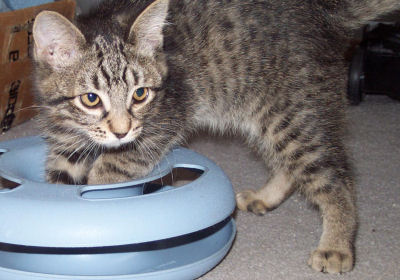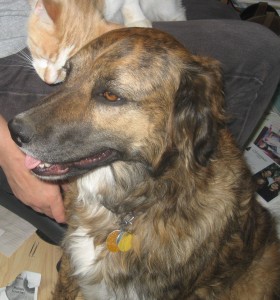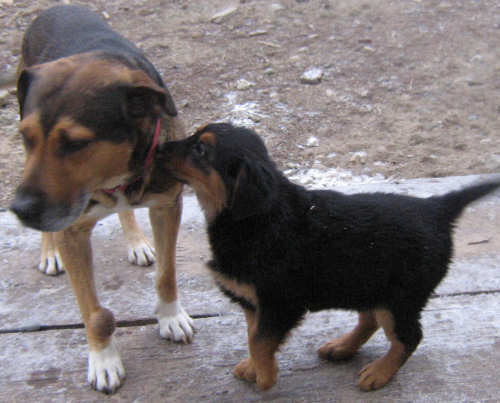One key to making successful shelter cat placements is managing the expectations of their new people. Here is some information, gleaned from various websites and the personal experiences of our adopters and volunteers, which we like to share with each cat adopter before the day they bring their new family member home. Have other ideas to help make the transition easier? Send us a comment below! You can never have too much good advice.
Welcome home!
Finding the cat of your dreams may have been easy, but fitting a new feline friend into your household usually requires a little patience and time.
To make your cat’s transition as comfortable as possible, we recommend placing her in a quiet, closed-in area such as a bedroom or a small room away from the main foot traffic and other pets, providing food, water, and a litterbox. Let your new pet get used to that one area for the first few days, sniffing your belongings and finding hiding places. Make frequent visits to play with, feed, pet, and interact with your new cat. Then you can begin slowly introducing her to the rest of your house, including the other pets. We recommend keeping cats indoors at all times for their health and safety, and that of the birds and other outdoor animals, BUT if you decide you want your cat to be an indoor/outdoor cat, do NOT let her go outside for at least two weeks after bringing her home, and then begin with short, supervised visits to the yard, so your cat can get her bearings and recognize her home turf. Always put a collar with ID information on a cat who goes outside.
INTRODUCING A NEW CAT TO A RESIDENT CAT
Your resident cat will sense this “intruder” in his home; be sure to spend extra time with your resident cat, to help relieve anxiety and tension. Place your resident cat’s food dish near the door to the room where the new cat is confined. Gradually move the confined cat’s food closer to the inside of the door. Feed them at the same time so they are separated by only the closed door. Some growling and hissing is to be expected – this is NORMAL and does not mean the cats will never tolerate each other!
When neither cat growls, hisses, or spits, you are ready to move on to the next step: confine your resident cat, with its own food, water, and litter box, to a location with which he is comfortable. Allow the new cat to explore your home for brief periods, accompanying it to give it the comfort of your presence as it explores. Then return the new cat to her “safe room” and let your resident cat out of its room.
It is a good idea to rub each cat with a cloth to transfer its scent to the cloth, then place the cloth with the other cat so they can get used to each other’s scents.
After several days of this, you may be ready to let both cats roam in your house for the first time; try to plan this for mealtime. Feed the cats in each other’s presence, placing their food dishes a comfortable distance apart. Some hissing and hesitation are to be expected; hopefully the food will distract them from each other. Wait only a few minutes after eating to return the new cat to its “safe room.” If either cat is too disturbed to eat in the other’s presence, return the new cat to its “safe room” and try again the next day. You can gradually move their food dishes closer to each other; allow the cats to spend progressively longer periods together after they have eaten. It is advisable to maintain one litter box for each cat, although when they have accepted each other, each cat will likely use both boxes. Be patient; most cats learn to accept each other over time.
Some anxiety in the resident cat can be alleviated by ignoring the new cat in the resident cat’s presence, and referring to the new cat as “resident-cat’s-name’s friend, new-cat’s-name” (example: “This is Sneakers’ friend Pumpkin, Sneakers will love to play with Pumpkin…”). Sounds weird, but it works!
INTRODUCING A NEW CAT TO A RESIDENT DOG
Be sure the dog is restrained on a firmly held short leash and the cat is free to escape; do not allow the cat to come within the dog’s biting range. if your dog guards its food, the cat may risk injury if it approaches the dog’s food, and it may be necessary to move the dog’s food or confine the cat. If the dog acts aggressively toward the cat, use corrective behavior techniques with the dog. Dogs can usually be trained to ignore, or even play with, cats.
COMMON ISSUES WITH A NEW CAT OR KITTEN
My kitten doesn’t use his litterbox!
Sometimes cats and kittens are a bit overwhelmed when going to their new home; if they are allowed to roam in too large a space, they may take some time to learn where the litterbox is, and this can lead to accidents. If you confine your new cat to one room at first, you can then gradually move his litterbox out of that room and into your preferred location, by moving it a few feet per day. The cat will most likely follow the box! If you witness your kitten missing the box, you can place the kitten into the box and move its paw in a scratching motion – this helps the kitten associate the box with a place it can bury its waste.
My cat uses his litterbox, but sometimes she prefers to use my houseplants!
Fresh dirt can be irresistible to some cats looking for a burial spot; to discourage this behavior, cover the soil surface with pinecones – big and spiny are best.
My cat has runny stools!
This is an extremely common situation for cats and kittens moving to a new home; cats have very sensitive digestive systems, and just the stress of a big change can be enough to bring on diarrhea. Changes in diet that occur in a new home can also contribute to this problem. It will usually clear up on its own in a few days; be sure the cat has enough water and easy access to the litterbox. If the problem persists or worsens, consult your veterinarian – although shelters do their best to prevent and eradicate diseases among cats, there are a number of minor things that can cause diarrhea; most are easily treated once identified by a stool sample.
My kitten is sneezing and has runny eyes and nose!
One of the most common ailments to strike cats and kittens right after moving to a new home is the upper respiratory infection, or URI. Again, stress is the culprit; kittens that showed no symptoms prior to being placed in the carrier for transport, can begin showing symptoms in a matter of hours after arriving in the vast, scary, unknown world of your house. Usually, the kitten’s immune system will fight off the URI in just a few days without any veterinary intervention. The closest human example is the common cold; when we are stressed, we are more susceptible to infection by the virus, but generally fight it off quickly with just a bit of chicken soup. (Yes, go ahead and give chicken soup to the kitten if it makes you feel better). If your kitten is not listless or dehydrated, and not running a very high fever, there really won’t be much else you can do to help them get over the “cold” besides cuddling and petting them (OK, OK, and chicken soup). If, however, your kitten’s nose or eyes begin secreting yellowish or greenish mucous, or the third eyelid begins showing prominently, or your kitten is extremely listless, he may be suffering from a secondary bacterial infection – those CAN be treated with a course of easily administered antibiotics, so definitely take him to see the doctor, and “supercharge” that chicken soup.
My kitten is shredding my couch!
Inappropriate scratching CAN be cured. The first thing is to provide several appropriate scratching places so your kitten can choose the material it likes; sisal posts, corrugated cardboard pads, even logs have been used with success. Then, to discourage the unwanted scratching, wrap the chosen item in tape, sticky side out – cats DESPISE this feeling on their paws.
My cat won’t come out from under the bed!
She is undoubtedly frightened and disoriented by being in a new place; use this room as her “safe room” for the first few days, and go in and talk quietly to her, read her a book, play music for her – but DON’T force her to come out. She wants to be friends – she’s just not sure what to expect. Take your time and show her you’re not a big, scary monster, and that she now belongs with you – no more cages or uncertainty! Cats can be a challenge, but a little patience works wonders.
Here’s a good article on cat communication: http://www.wikihow.com/Communicate-with-Your-Cat
Image Credits:
Cat Buddies: Copyright © 2003 Kim Gillen, available under CC-BY-SA 3.0 Unported.
Cat + Dog: Copyright © 2010 Sean Gillen, available under CC-BY-SA 3.0 Unported.







